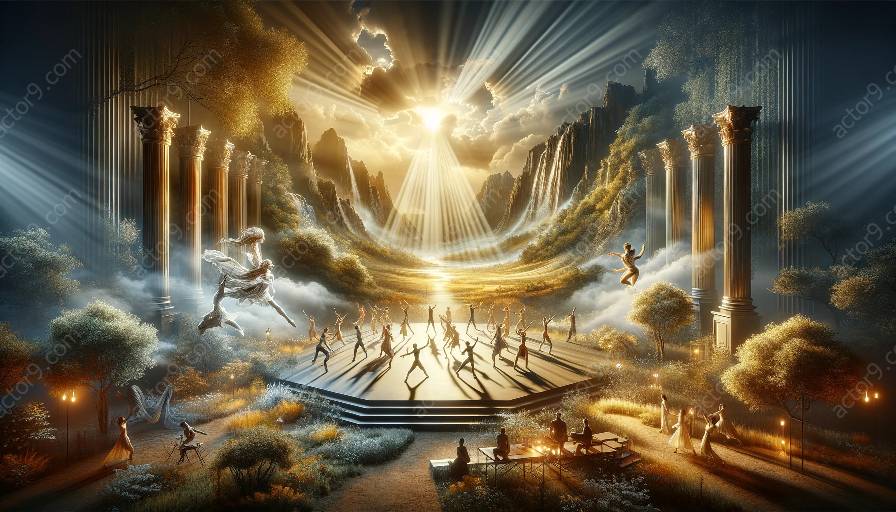Lighting design plays a crucial role in creating emotion and intimacy in physical theatre performances. By understanding the essential elements of lighting design and its connection to physical theatre, theatre practitioners can effectively enhance the audience experience and convey powerful narratives through light and shadow.
The Role of Lighting in Physical Theatre
In physical theatre, lighting serves multiple functions beyond mere visibility. It contributes to establishing atmospheres, setting moods, and guiding the audience's focus. Through the careful manipulation of light intensity, color, and direction, lighting can evoke emotions and create an immersive environment that complements the physical performances on stage.
Enhancing Emotional Impact
Lighting design has the power to amplify and underscore the emotional content of physical theatre performances. By using a strategic combination of light and shadow, designers can emphasize key moments, heighten tensions, and evoke specific emotional responses from the audience. The interplay of light and shadow can convey subtleties of mood and character, enhancing the depth and impact of the performance.
Creating Intimacy and Connection
Intimacy in physical theatre is often conveyed through subtle interactions and non-verbal communication. Lighting design can support this by delineating and accentuating moments of closeness, vulnerability, and connection between the performers. Through carefully crafted lighting cues, designers can create a sense of proximity and intimacy, drawing the audience into the private moments shared on stage.
Essential Elements of Lighting Design
Successful lighting design for physical theatre requires a comprehensive understanding of the essential elements that contribute to emotional resonance and intimacy. Designers must consider the qualities of light, its relationship to space and movement, and the integration of technology to create dynamic and evocative visual compositions that serve the narrative and thematic objectives of the performance.
Light Quality and Texture
The quality and texture of light significantly impact the emotional tone and visual richness of a physical theatre production. Soft, diffused light can convey a sense of intimacy and vulnerability, while harsh, directional light can create tension and stark contrasts. Designers carefully manipulate light sources and control the texture of light to evoke specific emotional responses and enhance the physicality of the performers.
Color and Symbolism
Color plays a symbolic and psychological role in influencing the audience's emotional experience. Lighting designers use color palettes to convey mood, evoke cultural associations, and signify transitions within the narrative. Warm colors may denote intimacy and passion, while cool colors can convey distance or melancholy. Thoughtful color choices contribute to the emotional resonance and thematic depth of physical theatre performances.
Dynamic Composition and Movement
Motion and dynamism are fundamental to physical theatre, and lighting design must seamlessly integrate with the performers' movements and spatial configurations. Dynamic lighting compositions can mirror the physicality of the performers, accentuating their gestures, expressions, and interactions. Through synchronized movement of light, designers can enhance the fluidity and emotional impact of the choreographed sequences, further amplifying the intimacy and connection between performers and audience.
Connection to Physical Theatre
Lighting design functions as an intrinsic element of physical theatre, shaping the visual and emotional landscapes that support the physical performances. It intersects with the physicality of the actors, dancers, and performers, emphasizing their movements and expressions, and establishing a harmonious relationship between the visual and kinesthetic elements of the production.
Collaborative Process
Effective integration of lighting design in physical theatre requires close collaboration between designers, directors, choreographers, and performers. Recognizing the interplay between light and movement, these creative stakeholders work together to craft compelling narratives that rely on the immersive synergy of lighting and physicality. Through iterative experimentation and feedback, they refine the lighting cues to maximize emotional impact and intimacy, ensuring a cohesive and resonant theatrical experience for the audience.
Immersive Audience Experience
Ultimately, the role of lighting in physical theatre is to enrich the audience's experience through heightened emotional engagement and a profound sense of connectedness. As integral contributors to the storytelling process, lighting designers shape the audience's perceptual journey, orchestrating the ebb and flow of emotions and intensifying the intimacy within the theatrical space. Their craft amplifies the visceral impact of physical theatre, allowing audiences to immerse themselves in the evocative interplay of movement, light, and emotions.




































